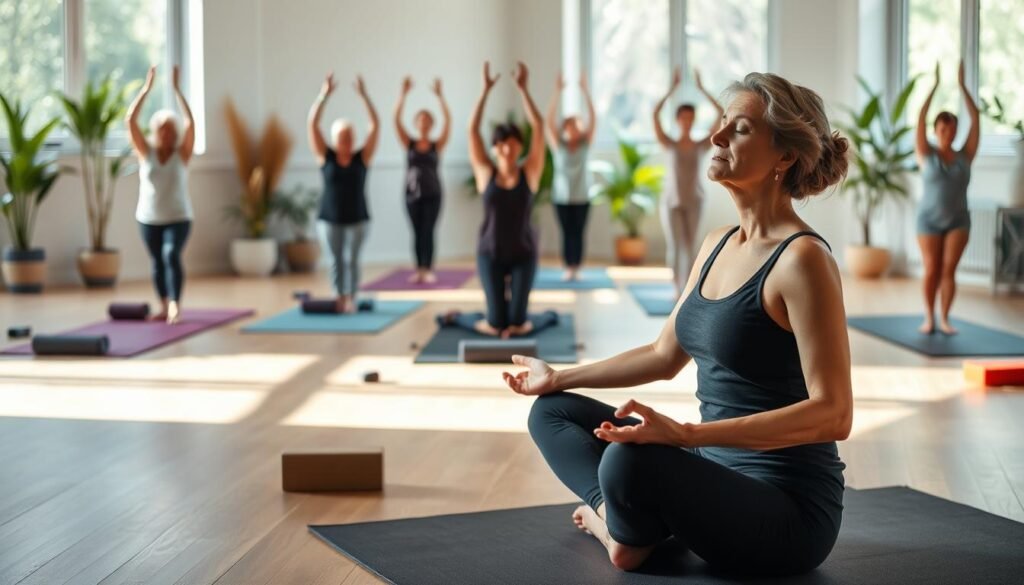Can a practice that combines physical postures, breathing techniques, and meditation really help alleviate chronic pain?
For many, the answer lies in yoga, an ancient practice that has been touted for its holistic benefits, including pain relief and improved mental well-being.
By incorporating mindfulness techniques and tailored physical postures, yoga can be a valuable tool in managing chronic pain, enhancing overall quality of life.
Key Takeaways
- Yoga combines physical postures, breathing techniques, and meditation to alleviate chronic pain.
- Mindfulness techniques in yoga enhance mental well-being.
- Tailored yoga practices can be adapted for individual chronic pain needs.
- Regular yoga practice can lead to improved pain management.
- Yoga promotes a holistic approach to health and wellness.
Understanding Chronic Pain and Its Impact
The experience of chronic pain is multifaceted, involving not just physical discomfort but also emotional and psychological distress. Chronic pain is a condition that persists over time, often beyond the normal healing period of an injury or illness.
What is Chronic Pain?
Chronic pain is typically defined as pain that lasts for more than 12 weeks. It can manifest in various forms, such as a dull ache, sharp stabbing pain, or burning sensation. Unlike acute pain, which serves as a warning sign for injury or illness, chronic pain can become a condition in itself, requiring comprehensive management strategies.
Common Types of Chronic Pain
There are several common types of chronic pain, including:
- Back pain: Often resulting from strain or injury to the muscles or spine.
- Arthritis pain: Caused by inflammation and degeneration of the joints.
- Neuropathic pain: Resulting from nerve damage, often described as shooting, burning, or stabbing pain.
- Fibromyalgia: Characterized by widespread muscle pain and fatigue.
Psychological Effects of Chronic Pain
Chronic pain can have significant psychological effects, including:
- Depression: The persistent nature of chronic pain can lead to feelings of sadness and hopelessness.
- Anxiety: Concerns about the future and the impact of pain on daily life can cause anxiety.
- Stress: Chronic pain can lead to increased stress levels, which in turn can exacerbate the pain.
Effective management of chronic pain requires a holistic approach that incorporates physical therapies like yoga, along with stress management techniques and psychological support. By addressing both the physical and emotional aspects of chronic pain, individuals can find relief and improve their overall quality of life.
The Role of Yoga in Pain Management
The practice of yoga offers a holistic approach to alleviating chronic pain. By combining physical postures, breathing techniques, and meditation, yoga addresses both the physical and psychological aspects of pain.
How Yoga Affects the Body
Yoga influences the body in several ways that can contribute to pain relief. Physical postures help maintain flexibility and strength, reducing the strain on muscles and joints. Breathing techniques and meditation can calm the nervous system, reducing stress and anxiety that often exacerbate chronic pain.
Some of the key mechanisms by which yoga affects the body include:
- Reducing inflammation through stress reduction
- Improving mood through the release of endorphins
- Enhancing sleep quality
- Improving flexibility and reducing muscle tension
Scientific Studies Supporting Yoga for Pain Relief
Numerous studies have investigated the effects of yoga on chronic pain, providing evidence of its benefits. A study published in the Journal of Pain Research found that yoga significantly reduced pain intensity and improved functional ability in patients with chronic low back pain.
Another study in the Journal of Rheumatology highlighted the positive effects of yoga on pain and disability in patients with rheumatoid arthritis. These studies support the inclusion of yoga as part of a comprehensive pain management plan.
The scientific evidence underscores the value of yoga as a complementary therapy for chronic pain management, offering a non-pharmacological approach to pain relief.
Essential Yoga Principles for Chronic Pain
Yoga offers a holistic approach to chronic pain management, centered around key principles that foster well-being. By integrating physical postures, breathing techniques, and meditation, yoga provides a comprehensive method for alleviating chronic pain.
Mindfulness and Awareness
Mindfulness is a foundational element of yoga that involves being fully present and aware of one’s body and surroundings. This awareness helps individuals with chronic pain to better understand their body’s limitations and capabilities, allowing for a more tailored approach to pain management. Practicing mindfulness can lead to reduced stress and anxiety, which are often associated with chronic pain.
Mindfulness techniques can be incorporated into daily activities, not just during yoga practice. For example, paying attention to the breath, noticing the sensations in the body, and being aware of one’s thoughts without judgment can all contribute to a greater sense of well-being.
Connecting Breath with Movement
The synchronization of breath with movement is another crucial principle of yoga. This connection enhances the benefits of yoga postures by promoting relaxation, improving circulation, and increasing oxygenation of the body’s tissues. By focusing on the breath, individuals can better manage pain and reduce discomfort.
Breathing techniques, such as diaphragmatic breathing, can be particularly beneficial for individuals with chronic pain. These techniques help to calm the nervous system, reduce stress, and promote relaxation.
| Breathing Technique | Description | Benefits for Chronic Pain |
|---|---|---|
| Diaphragmatic Breathing | Engages the diaphragm, promoting deep, relaxed breathing. | Reduces stress, promotes relaxation. |
| 4-7-8 Breathing | Involves breathing in through the nose for 4 seconds, holding for 7 seconds, and exhaling through the mouth for 8 seconds. | Calms the nervous system, aids in falling asleep. |
| Alternate Nostril Breathing | Balances the breath by alternating between nostrils. | Reduces anxiety, promotes balance. |
By incorporating these essential yoga principles into their practice, individuals with chronic pain can experience significant improvements in their overall well-being and pain management.
Choosing the Right Yoga Style for You
Yoga offers various styles, each with unique benefits for managing chronic pain, making the choice of style a personal and significant decision. The right yoga style can enhance your practice, providing relief and improving overall well-being.
Gentle Relief with Hatha Yoga
Hatha Yoga is a traditional and classical form of yoga that focuses on physical postures (asanas) and breathing techniques (pranayama). It is an excellent choice for those seeking gentle relief from chronic pain. Hatha Yoga’s slow and gentle approach helps in improving flexibility, balance, and strength, making it suitable for beginners and those with chronic pain.
Deep Stretching with Yin Yoga
Yin Yoga targets the deeper tissues of the body, such as the connective tissues, through slow-paced, meditative postures. It involves holding poses for extended periods, typically 3-5 minutes, to promote deep stretching and relaxation. Yin Yoga is beneficial for improving flexibility and reducing chronic pain by releasing tension in the joints and muscles.
Relaxation through Restorative Yoga
Restorative Yoga is a therapeutic form of yoga that involves using props to support the body in relaxing postures, allowing for deep relaxation and rejuvenation. This style is particularly beneficial for individuals with chronic pain as it encourages the body to heal and relax, reducing stress and tension.
Each of these yoga styles offers unique benefits for managing chronic pain. By understanding the characteristics of Hatha, Yin, and Restorative Yoga, individuals can make an informed decision about which style suits their needs best, enhancing their practice and contributing to effective pain management.
Key Yoga Poses for Chronic Pain Relief
Yoga poses, when practiced correctly, can be a powerful tool in the management of chronic pain. By incorporating specific poses into your routine, you can experience significant relief and improvement in your overall well-being.
Child’s Pose for Back Pain
Child’s Pose, or Balasana, is a gentle stretch that can help alleviate back pain. To perform this pose, kneel on the mat, then sit back onto your heels. Stretch your arms out in front of you, lowering your forehead to the ground. This pose helps to stretch the back muscles and promote relaxation.
Cat-Cow Stretch for Spinal Flexibility
The Cat-Cow Stretch is a dynamic movement that improves spinal flexibility and reduces tension in the neck and torso. Begin on your hands and knees. Inhale, arching your back and lifting your tailbone (Cat Pose). Exhale, rounding your back and tucking your chin to your chest (Cow Pose). Repeat several times, moving slowly and smoothly.
Warrior II for Strength and Stability
Warrior II, or Virabhadrasana II, is a standing pose that strengthens the legs and promotes stability. Stand with your feet wide apart, with one foot facing forward and the other foot at a 90-degree angle. Bend your front knee over your ankle, stretching your arms out to the sides. This pose helps build strength and confidence.
The following table summarizes the benefits and key aspects of these yoga poses:
| Pose | Benefits | Key Aspects |
|---|---|---|
| Child’s Pose | Relieves back pain, promotes relaxation | Kneel, sit back on heels, stretch arms forward |
| Cat-Cow Stretch | Improves spinal flexibility, reduces tension | Move on hands and knees, inhale and exhale with arching and rounding back |
| Warrior II | Strengthens legs, promotes stability | Stand with feet wide apart, bend front knee, stretch arms to sides |
By incorporating these poses into your yoga practice, you can experience significant relief from chronic pain and improve your overall quality of life. Remember to practice regularly and listen to your body to maximize the benefits.
Relaxation Exercises to Complement Your Practice
Complementing your yoga practice with relaxation techniques can lead to improved pain management outcomes. Relaxation exercises are designed to reduce stress and promote overall well-being, making them an ideal complement to yoga for chronic pain relief.

Guided Imagery Techniques
Guided imagery involves using visualization to create a mental state of relaxation and calmness. By focusing on peaceful imagery, individuals can distract themselves from pain and reduce stress levels.
To practice guided imagery, find a quiet and comfortable space, close your eyes, and begin to breathe deeply. Imagine yourself in a serene environment, such as a beach or a forest, and engage all your senses in the experience.
Progressive Muscle Relaxation
Progressive muscle relaxation is a technique that involves systematically tensing and relaxing different muscle groups in the body. This method helps to release physical tension and promote relaxation.
Start by tensing the muscles in your toes, holding for a few seconds, and then release. Gradually work your way up through the body, tensing and relaxing each muscle group in turn.
Visualization for Pain Management
Visualization involves using the mind to create images that promote relaxation and reduce pain perception. By visualizing positive outcomes and scenarios, individuals can better manage their chronic pain.
A simple visualization technique is to imagine a warm, soothing light filling the areas of the body that are experiencing pain. As you inhale, visualize this light entering the body; as you exhale, imagine it carrying pain away.
| Technique | Description | Benefits |
|---|---|---|
| Guided Imagery | Visualization of peaceful scenes | Reduces stress, distracts from pain |
| Progressive Muscle Relaxation | Systematic tensing and relaxing of muscles | Releases physical tension, promotes relaxation |
| Visualization | Creating mental images to reduce pain | Promotes relaxation, reduces pain perception |
By incorporating these relaxation exercises into your daily routine, you can enhance the benefits of your yoga practice and improve your overall management of chronic pain.
Breathing Techniques to Support Healing
To complement yoga practices, several breathing techniques can be employed to foster a deeper state of relaxation and well-being. These techniques not only enhance the benefits of yoga but also provide a powerful tool for managing stress and promoting overall health.
Diaphragmatic Breathing
Diaphragmatic breathing, also known as belly breathing, engages the diaphragm to fill the lungs fully. This technique slows down the heart rate and lowers blood pressure, contributing to a state of relaxation.
- Begin by placing one hand on the abdomen and the other on the chest.
- Inhale deeply through the nose, allowing the abdomen to rise while the chest remains still.
- Exhale slowly through the mouth, feeling the abdomen fall.
4-7-8 Breathing Method
The 4-7-8 breathing method, also known as the “Relaxation Breath,” involves breathing in through the nose for a count of 4, holding the breath for a count of 7, and exhaling through the mouth for a count of 8. This technique can induce a state of calm and reduce anxiety.
- Start by sitting comfortably with the back straight.
- Close the eyes and inhale through the nose for a count of 4.
- Hold the breath for a count of 7.
- Exhale through the mouth for a count of 8.
Alternate Nostril Breathing
Alternate Nostril Breathing is a technique used in yoga to balance the breath and calm the mind. It involves closing one nostril and breathing in through the other, then switching to exhale through the other nostril.
- Begin by sitting comfortably with the right hand in front of the face.
- Close the right nostril with the thumb and inhale through the left nostril.
- Close the left nostril with the ring finger and exhale through the right nostril.
- Inhale through the right nostril, close it, and exhale through the left nostril.
By incorporating these breathing techniques into your daily routine, you can enhance your yoga practice and promote a deeper sense of relaxation and well-being.
Creating a Personal Yoga Routine for Pain Relief
Creating a yoga practice that is personalized to one’s needs can significantly enhance its effectiveness in managing chronic pain. A well-tailored routine considers individual limitations, goals, and the type of chronic pain being experienced.
Tailoring Poses to Your Needs
When tailoring poses, it’s essential to start with gentle stretches and gradually move to more complex poses based on comfort and ability. For instance, individuals with lower back pain may find relief in Child’s Pose or Cat-Cow Stretch.
Modifying poses is crucial to avoid exacerbating the pain. For example, substituting deep forward bends with gentle knee bends can be more comfortable for those with certain types of chronic pain.
| Common Chronic Pain Areas | Beneficial Yoga Poses | Modifications |
|---|---|---|
| Lower Back | Child’s Pose, Cat-Cow Stretch | Use a bolster under the chest for support |
| Neck and Shoulders | Shoulder Rolls, Neck Stretch | Avoid deep neck stretches if experiencing sharp pain |
| Knees | Leg Raises, Seated Forward Bend (modified) | Use a strap to support the leg if necessary |
Setting Realistic Goals
Setting achievable goals is vital for maintaining motivation and tracking progress. Goals should be specific, measurable, and aligned with your pain management needs. For example, aiming to practice yoga for 10 minutes, three times a week, is a realistic starting point.
Regularly reviewing and adjusting your goals based on your progress can help in maintaining a consistent and effective practice. Celebrating small achievements along the way can also enhance motivation.
Safety Tips for Practicing Yoga with Chronic Pain
Yoga can be a valuable tool for managing chronic pain, but safety should always be the top priority. When practiced mindfully, yoga can help alleviate pain and improve overall well-being. However, it’s crucial to approach your practice with caution and awareness of your body’s limitations.

Listening to Your Body
One of the most important aspects of practicing yoga with chronic pain is listening to your body. This means being aware of your physical sensations and honoring your limits. If you experience pain or discomfort, stop immediately and modify the pose or rest.
Mindfulness techniques can help you tune into your body’s signals. By cultivating awareness of your breath and physical sensations, you can better understand what your body needs and avoid pushing yourself too far.
Modifying Poses for Comfort
Modifying yoga poses is essential for making your practice comfortable and safe. Many poses can be adapted to accommodate physical limitations or pain. For example, using props like blocks, blankets, or chairs can help you maintain proper alignment and reduce strain on your joints and muscles.
It’s also helpful to work with a qualified yoga instructor who has experience with students with chronic pain. They can provide personalized guidance on modifying poses and developing a practice that suits your needs.
By combining mindfulness techniques with gentle, modified yoga poses, you can create a practice that supports your overall health and helps manage chronic pain effectively.
Integrating Natural Therapy into Your Practice
The integration of natural therapies into yoga practice offers a holistic approach to managing chronic pain. By combining physical postures, breathing techniques, and natural therapies, individuals can experience a more comprehensive relief from chronic pain.
Nutrition and Its Effects on Pain
A well-balanced diet plays a significant role in managing chronic pain. Certain foods have anti-inflammatory properties that can help reduce pain, while others may exacerbate it. Incorporating foods rich in omega-3 fatty acids, such as salmon and walnuts, can help alleviate inflammation.
Understanding the impact of nutrition on pain is crucial. For instance, a diet high in processed foods and sugars can lead to increased inflammation, whereas a diet rich in fruits, vegetables, and whole grains can help reduce it.
| Food Group | Examples | Effect on Pain |
|---|---|---|
| Fruits | Berries, Citrus Fruits | Anti-inflammatory |
| Vegetables | Leafy Greens, Cruciferous Vegetables | Anti-inflammatory |
| Proteins | Fatty Fish, Nuts, Seeds | Anti-inflammatory |
| Grains | Whole Grains | Reduces Inflammation |
Herbal Remedies to Consider
Herbal remedies have been used for centuries to manage pain and inflammation. Turmeric, with its active compound curcumin, is known for its potent anti-inflammatory and pain-relieving properties.
Other herbal remedies such as ginger, willow bark, and devil’s claw have also been found to be effective in managing chronic pain. It’s essential to consult with a healthcare professional before adding any herbal remedies to your regimen.
Finding Community Support and Classes
Finding the right community support can significantly enhance your yoga practice and overall well-being. When managing chronic pain, having a supportive community can make a substantial difference in your journey.
Local Yoga Studios vs. Online Classes
When it comes to finding a yoga community, you have the option of joining local yoga studios or participating in online classes. Local yoga studios offer a more personal, face-to-face interaction with instructors and fellow practitioners, which can be beneficial for those who thrive in a social environment.
On the other hand, online classes provide flexibility and convenience, especially for those with mobility issues or those who prefer practicing in the comfort of their own homes. Online platforms often offer a wide range of classes and instructors, catering to different needs and preferences.
| Criteria | Local Yoga Studios | Online Classes |
|---|---|---|
| Interaction | Face-to-face with instructors and peers | Virtual interaction through live chats or forums |
| Flexibility | Limited by studio schedules | Available 24/7, flexible scheduling |
| Accessibility | Dependent on location, may require travel | Accessible from anywhere with an internet connection |
Support Groups for Chronic Pain
In addition to yoga classes, joining support groups specifically for individuals with chronic pain can provide an additional layer of emotional support and understanding. These groups offer a space to share experiences, tips, and encouragement with others who are facing similar challenges.
Support groups can be found through local community centers, hospitals, or online platforms. They can be a valuable resource for coping with the emotional and psychological aspects of chronic pain.
Conclusion: Embracing Yoga for a Healthier Life
As we’ve explored throughout this article, yoga offers a holistic approach to managing chronic pain. By incorporating yoga into your daily routine, you can experience significant improvements in your overall well-being.
Practicing Yoga for Long-Term Benefits
A consistent yoga practice can lead to long-term benefits, including reduced pain levels and improved flexibility. Regular practice of pain management exercises, such as those outlined in this article, can help you achieve a better quality of life.
Continuing Your Yoga Journey
To continue your yoga journey, consider exploring different yoga styles and techniques. This will help keep your practice engaging and prevent plateaus. By committing to a regular yoga practice, you can enjoy the many benefits that yoga has to offer.



